Geography of IrelAnd
1.
Overview
2.
Topography of the UK
3.
Climate
4.
Natural resources of the
Republic of Ireland
5.
National Parks in
the Republic of Ireland
6. Dublin
7.
Demographic overview the Republic of Ireland
Overview
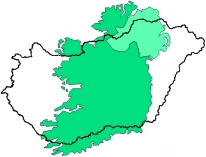 Ireland is the third
largest island in Europe, almost the same size as Hungary.
Ireland is divided into the Republic of Ireland, with its capital Dublin. This state is often simply referred to
as 'Ireland' or 'Éire' in Irish. Northern Ireland is unofficially known as 'Ulster'
although some parts of the historic province of Ulster were annexed to the
Republic when the county was devided in 1922.
The Republic of Ireland
occupies about the five sixths (70,273 sq km) of the land area of the island.
Northern Ireland, the north-eastern sixth belongs to the United Kingdom. The island lying
in the Atlantic Ocean in a 80 km distance from Great Britain separated from it
by the Irish Sea and the St. George's Channel. Ireland is about 302 miles (486
km) long in the north-south direction and its maximum width is about 174 miles
(280 km) from east to west.
Topographically the surface of Ireland is very similar to Hungary and can be
described as a basin. The central low plain is
surrounded by a ring of coastal mountains. This
chain consist of 14 mountains,
three of which belongs to Norther Ireland (see map). The mountains in the southern part of the chain is
higher including the three
highest peeks in Ireland. The Carrauntuohill
in Macgillycuddy's Reeks, Kerry is the highest with 1041 m.
The
Mourne
Mountains
are the most picturesque mountain district in
Ireland.
The twelve peaks include Slieve
Donard, which at 850 m is
Northern
Ireland's
highest mountain (
Ireland is the third
largest island in Europe, almost the same size as Hungary.
Ireland is divided into the Republic of Ireland, with its capital Dublin. This state is often simply referred to
as 'Ireland' or 'Éire' in Irish. Northern Ireland is unofficially known as 'Ulster'
although some parts of the historic province of Ulster were annexed to the
Republic when the county was devided in 1922.
The Republic of Ireland
occupies about the five sixths (70,273 sq km) of the land area of the island.
Northern Ireland, the north-eastern sixth belongs to the United Kingdom. The island lying
in the Atlantic Ocean in a 80 km distance from Great Britain separated from it
by the Irish Sea and the St. George's Channel. Ireland is about 302 miles (486
km) long in the north-south direction and its maximum width is about 174 miles
(280 km) from east to west.
Topographically the surface of Ireland is very similar to Hungary and can be
described as a basin. The central low plain is
surrounded by a ring of coastal mountains. This
chain consist of 14 mountains,
three of which belongs to Norther Ireland (see map). The mountains in the southern part of the chain is
higher including the three
highest peeks in Ireland. The Carrauntuohill
in Macgillycuddy's Reeks, Kerry is the highest with 1041 m.
The
Mourne
Mountains
are the most picturesque mountain district in
Ireland.
The twelve peaks include Slieve
Donard, which at 850 m is
Northern
Ireland's
highest mountain ( ).
The large central lowland is
interrupted by low hills and has large areas of
bog
and numerous lakes. The main river in Ireland is the River
Shannon, 386 km (240 miles), the longest river in the British Isles,
which separates the boggy midlands
and connects three lakes (loughs) during its way to the Atlantic. Other
important rivers are the Liffey (drains into the sea at Dublin), the Boyne and
the Blackwater (
).
The large central lowland is
interrupted by low hills and has large areas of
bog
and numerous lakes. The main river in Ireland is the River
Shannon, 386 km (240 miles), the longest river in the British Isles,
which separates the boggy midlands
and connects three lakes (loughs) during its way to the Atlantic. Other
important rivers are the Liffey (drains into the sea at Dublin), the Boyne and
the Blackwater ( ).
).
|
According to an Irish legend that the giant,
Fionn mac Cumhail, was fighting with another in Scotland, and enraged,
scooped out a lump of earth, which he threw. It fell into the Irish Sea,
creating the Isle of Man, while the hole filled up with water to become
Lough Neagh. |
Lough Neagh, in Ulster, is the biggest lake in Ireland;
there are more than a hundred. The loughs in Ireland are primarily a result of
glaciation,
just like the river valleys. The loughs Allen, Ree, and Derg were formed by
overdeepening of parts of the River Shannon’s bed during glaciation. The coast
in the west and south-west is very indented with inlets and bays where the
mountains thrust out into the Atlantic. The bays provide safe anchorage and many
have developed into harbours, including the Shannon estuary, Galway Bay,
Waterford Harbour, and Cork Harbour. Bantry Bay is one of western Europe’s
principal deep-sea anchorages. There are many islands off the western coast the
biggest of which is the Achill Island ( ).
The island is inhabited, and is connected to the mainland by a bridge.
).
The island is inhabited, and is connected to the mainland by a bridge.
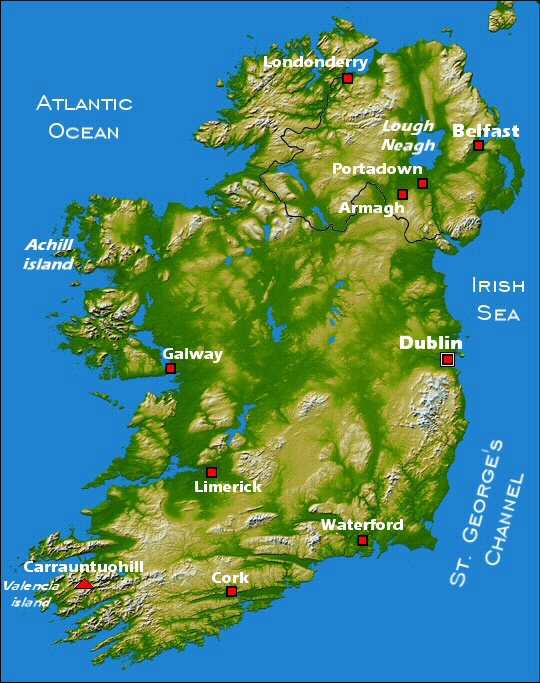
Climate
The climate of Ireland does not differ from those that other parts of the
British Isles has. It is influenced
by the Gulf Stream and with the prevailing winds predominantly from the
south-west. The wind is braking on the high
mountains of the west coast therefore the annual rainfall on the Valentia Island
(1400 mm), off the south-west coast, is almost twice as much as in Dublin on the
east (762 mm). In
mountainous areas annual rainfall may exceed 2000mm. Rainfall is normally well distributed
throughout the year but about 60% of the total falls between August and January.
The temperatures are fairly uniform over the whole country. The coldest months
are January and February with mean daily air temperatures of between 4°C and
7°C, while July and August are the 'warmest' (14°C to 16°C). Extremes of air
temperature, below -10°C or above 30°C, are very rare. May and June are the sunniest
months, averaging 5 to 7 hours of sunshine per day (It is nearly 10 hours in
Hungary).
Natural resources of the
Republic of Ireland
Ireland is quite poor in mineral resources, however Ireland is a leading
producer of zinc ores and one of the world's largest zinc/lead mines is
located near Navan, County Meath.
Peat
 is an important domestic fuel. There is little coal, but natural gas
reserves off the coast of County Cork have been in production since the
1980s.
is an important domestic fuel. There is little coal, but natural gas
reserves off the coast of County Cork have been in production since the
1980s.
National Parks in
the Republic of Ireland
In 1969, the International Union for the
Conservation of Nature (IUCN) recommended that all governments agree to reserve
the term 'National Park' to areas sharing the following characteristics:
1. Where one or several ecosystems are not materially altered by human
exploitation and occupation; where plant and animal species, geomorphological
sites and habitats are of special scientific, educational and recreational
interest or which contain a natural landscape of great beauty;
2. Where the highest competent authority of the country has taken steps to
prevent or eliminate as soon as possible exploitation or occupation in the whole
area and to enforce effectively the respect of ecological, geomorphological or
aesthetic features which have led to its establishment;
3. Where visitors are allowed to enter, under special conditions, for
inspirational, educational, cultural and recreational purposes.
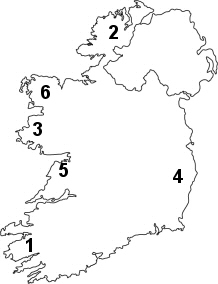
There are six
National Parks in Ireland. These are:
1. Killarney National Park, Co. Kerry (10,289
ha) It was the first in 1932
2. Glenveagh National Park, Co. Donegal
(16,958ha)
3. Connemara National Park, Co. Galway (2,957
ha)
4. Wicklow Mountains National Park, Co. Wicklow
(15,925 ha)
5. The Burren National Park, Co. Clare (1,673
ha)
6. Ballycroy National Park, Co. Mayo (11,779
ha) It was the latest in 1998

Dublin
 Dublin was founded in the early ninth century when Vikings
made their largest settlement outside of Scandinavia on the site of the present
day city. Ever since then, Dublin has suffered many wars and conflicts. The city
has been Ireland's capital city since mediæval times. In the
early 20th century, Dublin established its own identity and is today a modern,
cosmopolitan city which is rich in history and proud of its past. Nearly half
million people live in the city. Dublin is
special, a place where tradition and cultural heritage have merged seamlessly
over the centuries to create an atmosphere simply unique to Dublin. Dublin is
renowned world wide as a city of writers and literature, home to such literary
pens as Joyce, Shaw and many others, celebrated at the
Dublin Writers Museum,
James Joyce Museum and the
Shaw
Dublin was founded in the early ninth century when Vikings
made their largest settlement outside of Scandinavia on the site of the present
day city. Ever since then, Dublin has suffered many wars and conflicts. The city
has been Ireland's capital city since mediæval times. In the
early 20th century, Dublin established its own identity and is today a modern,
cosmopolitan city which is rich in history and proud of its past. Nearly half
million people live in the city. Dublin is
special, a place where tradition and cultural heritage have merged seamlessly
over the centuries to create an atmosphere simply unique to Dublin. Dublin is
renowned world wide as a city of writers and literature, home to such literary
pens as Joyce, Shaw and many others, celebrated at the
Dublin Writers Museum,
James Joyce Museum and the
Shaw
Birthplace.
Malahide Castle is a beautifully
restored residence with distinctive elegance and charm. The extensive grounds of
|
The demographic division of the city dates back centuries, certainly to the point when the Earl of Kildare
built his residence on the then less regarded Southside. When asked why
he was building on the South Side, he replied "Where I go, fashion
follows me", and indeed he was promptly followed by most other Irish peers. |
the Malahide Castle Demense are also home to the delightful
Fry Model Railway and the Talbot
Botanic Gardens. Malahide Castle is also the home to Tara's Palace, one of the
world's most significant Dolls Houses. There is a vibrant night life in Dublin - the most internationally notorious area for these activities is the Temple Bar
area south of the river Liffey. Dublin is the primary centre of education in Ireland, with three
universities and several other higher education institutions. The University of Dublin
is the oldest university in Ireland dating from the 16th Century. Traditionally, a north versus south division has existed in Dublin with the dividing line provided by the River Liffey. The Northside is generally seen as working-class, while the Southside
is seen as middle and upper middle class. According to the lates surveys Dublin
is the 16th most expensive city in the world, and rated as the city with the
24th best quality of life in the world.The headquarters of almost all of Ireland's sporting organisations are located in Dublin.
The capital is also the headquarters of all type of medium: Radio Telifís Éireann
(RTÉ), Ireland's national state broadcaster (TV & Radio); important national
newspapers such as The Irish Times and Irish Independent; and Vodafone. Dublin
is the centre of the transport system in Ireland: the country's most
important sea port and airport is located here. Dublin is also the main hub of the country's road network. The M50 motorway (the busiest road in Ireland), a semi-ring road ( It's like M0 around Budapest)
runs around the south, west and north
of the city, connecting the most important national primary routes in the State
that fan out from the capital to the regions. Dublin does not have underground
(it is planned in the next 10 years) hence the bulk of the public transport
system in Dublin is made up of bus services operated by Dublin Bus, which
operates a network of nearly 200 daytime routes.
It's like M0 around Budapest)
runs around the south, west and north
of the city, connecting the most important national primary routes in the State
that fan out from the capital to the regions. Dublin does not have underground
(it is planned in the next 10 years) hence the bulk of the public transport
system in Dublin is made up of bus services operated by Dublin Bus, which
operates a network of nearly 200 daytime routes.
Probably the most famous industry in Dublin is brewing: Guinness
has been brewed here since 1759. During the Celtic Tiger
years of the mid to late nineties a large number of pharmaceutical and
information technology companies have located in Dublin and its suburbs
and the large volume of computer industry in Dublin has led to it being
referred to as the Silicon Valley of Europe.

Demographic overview the Republic of Ireland
The present population is
just over 4,000,000, the highest on record since 1871. The
distribution of the population between urban2 and rural areas has undergone
a major transformation in the period since the foundation of the State.
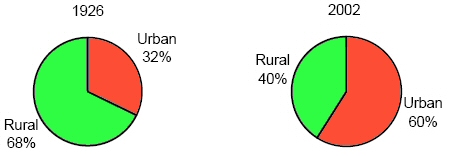
Over
40% of the population resides within 100 km of Dublin. The major centres of population are
Dublin,
Cork,
Galway,
Limerick and
Waterford.
Sixty per cent of the population live in cities and towns of 1,000 people or
more. A high proportion of the population is concentrated in the younger age
groups. As a consequence of improved economic performance in recent years there
has been a significant increase in net migration.
|
|
0-14 years: 20.9% ( 15.6%)
15.6%)
15-64 years: 67.5% ( 69.2%)
69.2%)
65 years and over: 11.5% ( 15.2%) (2005 est.)
15.2%) (2005 est.)
The relative sizes of the dependency groups
- young population
(aged 0-14 years) and the old population (aged 65 years and over) - are
decreasing resulting in a more stable economy and welfare.
Age dependency ratios -
derived by
expressing the young population and the old population as percentages of the
population of working age (15-64 years).
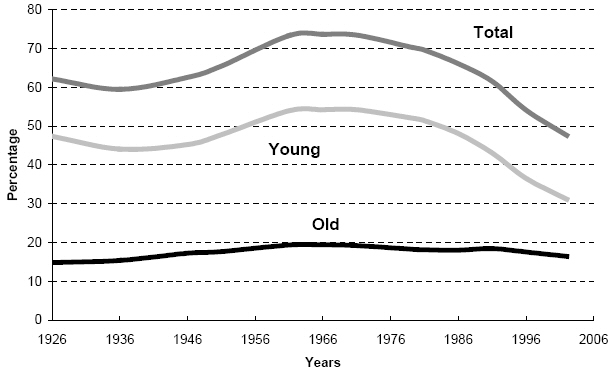
|
|
|
1.16% ( -0.25%) (2005 est.)
-0.25%) (2005 est.) |
Life expectancy at birth:
|
total population: 77.6 years
( 72.7 years)
72.7 years)
male: 75.0 years ( 68.5 years)
68.5 years)
female: 80.3 years ( 77.1 years) (2005 est.)
77.1 years) (2005 est.) |
|
|
Celtic, English |
|
|
Roman Catholic 88.4%, Church of Ireland (Anglican) 3%, other
Christian 1.6%, other 1.5%, unspecified 2%, none 3.5% (2002 census)
Regular Mass attendance among the Roman Catholic is
continuously decreasing: it was more than 90% in 1973, today it is below
50%. The Church of Ireland, with a largely elderly membership is declining
also. It had been forced to close down many of its rural churches, and even
some in urban areas. The very small Jewish community in Ireland is also
ageing and sees many of its younger adherents emigrating to Israel. The
religions showing major growth are Islam and small born-again Christian
faiths associated with Ireland's growing immigrant communities.
The number of Muslims and Orthodox
adherents experienced major change since
the 1991 census, the former almost quadrupling and the latter increasing
from less than 400 adherents in 1991 to over 10,000 in 2002. Both
categories have also been clearly affected by immigration flows. |
|
|
English (official) is the language generally used, Irish
(official) (Gaelic or Gaeilge) spoken mainly in areas located along the
western seaboard.
Approximately 1.57
million persons aged three years of age and over were recorded as being able
to speak Irish in 2002. This represents 42.8 per cent of the total
population. The age groups with the highest proportions of persons able to
speak Irish were those corresponding to the school-going population (Irish
Gaelic is a compulsory subject in secondary school.).
Ability to speak
Irish by age group and sex, 2002
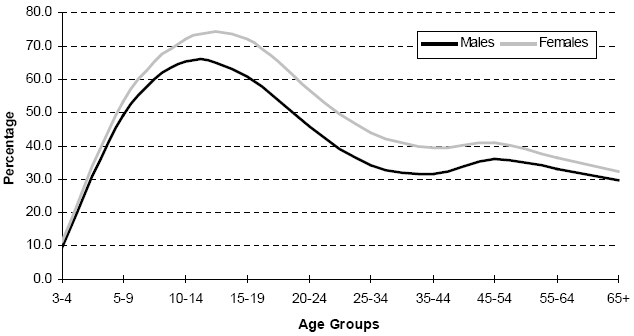
Of those who could speak Irish 21.6 per
cent were reported as speaking it on a daily basis compared with 24.7 per
cent in 1996. Most of these (76.8%) were in the school-going ages 5-19
years. Nearly
two thirds of persons who were recorded as being able to speak Irish either
never spoke it or spoke it less frequently than weekly. Irish speakers
represented more than 70 per cent of the population aged 3 years and over
within Gaeltacht areas (West and South) in 2002. |
|
|
definition: age 15 and over can read and write
total population: 98% (1981 est.) |
 vocabulary:
vocabulary:
|
topographically |
domborzatilag |
|
bog |
mocsár, ingovány |
|
glaciation |
itt [jégkorszakbeli] gleccserműködés |
|
peat |
tőzeg |
learn more:
Geography
of Ireland
Monthly economic bulletins
sources:
Wikipedia,
Geography of Ireland
Wikipedia,
Demographics of the Republic of Ireland
Microsoft Encarta
National Parks in Ireland
CIA - The World Factbook
Census 2002 - Principal
Demographic Results
credits
Dublin:
extracted from
Wikipedia The Free Encyclopedia
under
GNU Free Documentation Licence.
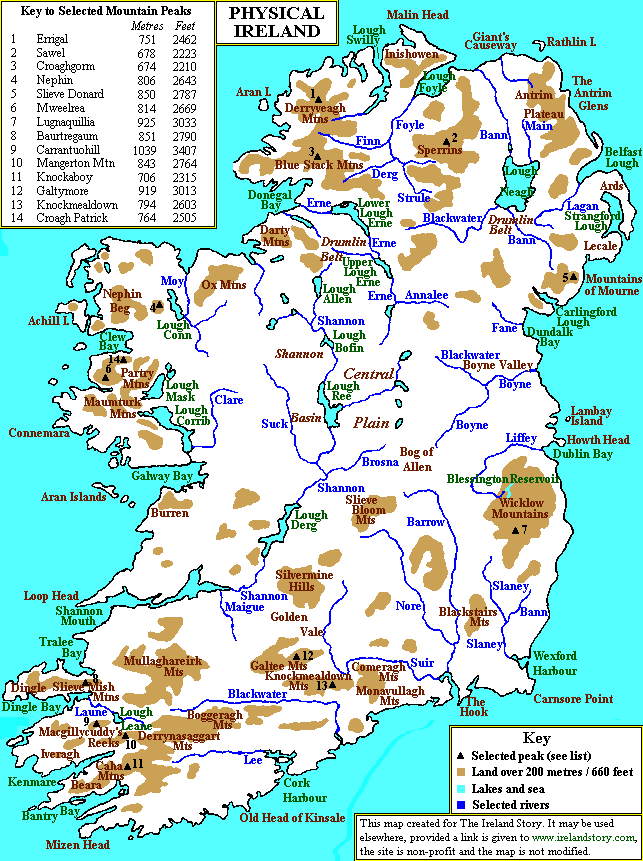
 Ireland is the third
largest island in Europe, almost the same size as Hungary.
Ireland is divided into the Republic of Ireland, with its capital Dublin. This state is often simply referred to
as 'Ireland' or 'Éire' in Irish. Northern Ireland is unofficially known as 'Ulster'
although some parts of the historic province of Ulster were annexed to the
Republic when the county was devided in 1922.
The Republic of Ireland
occupies about the five sixths (70,273 sq km) of the land area of the island.
Northern Ireland, the north-eastern sixth belongs to the United Kingdom. The island lying
in the Atlantic Ocean in a 80 km distance from Great Britain separated from it
by the Irish Sea and the St. George's Channel. Ireland is about 302 miles (486
km) long in the north-south direction and its maximum width is about 174 miles
(280 km) from east to west.
Topographically the surface of Ireland is very similar to Hungary and can be
described as a basin. The central low plain is
surrounded by a ring of coastal mountains. This
chain consist of 14 mountains,
three of which belongs to Norther Ireland (see map). The mountains in the southern part of the chain is
higher including the three
highest peeks in Ireland. The Carrauntuohill
in Macgillycuddy's Reeks, Kerry is the highest with 1041 m.
The
Ireland is the third
largest island in Europe, almost the same size as Hungary.
Ireland is divided into the Republic of Ireland, with its capital Dublin. This state is often simply referred to
as 'Ireland' or 'Éire' in Irish. Northern Ireland is unofficially known as 'Ulster'
although some parts of the historic province of Ulster were annexed to the
Republic when the county was devided in 1922.
The Republic of Ireland
occupies about the five sixths (70,273 sq km) of the land area of the island.
Northern Ireland, the north-eastern sixth belongs to the United Kingdom. The island lying
in the Atlantic Ocean in a 80 km distance from Great Britain separated from it
by the Irish Sea and the St. George's Channel. Ireland is about 302 miles (486
km) long in the north-south direction and its maximum width is about 174 miles
(280 km) from east to west.
Topographically the surface of Ireland is very similar to Hungary and can be
described as a basin. The central low plain is
surrounded by a ring of coastal mountains. This
chain consist of 14 mountains,
three of which belongs to Norther Ireland (see map). The mountains in the southern part of the chain is
higher including the three
highest peeks in Ireland. The Carrauntuohill
in Macgillycuddy's Reeks, Kerry is the highest with 1041 m.
The


 Dublin was founded in the early ninth century when Vikings
made their largest settlement outside of Scandinavia on the site of the present
day city. Ever since then, Dublin has suffered many wars and conflicts. The city
has been Ireland's capital city since mediæval times. In the
early 20th century, Dublin established its own identity and is today a modern,
cosmopolitan city which is rich in history and proud of its past. Nearly half
million people live in the city. Dublin is
special, a place where tradition and cultural heritage have merged seamlessly
over the centuries to create an atmosphere simply unique to Dublin. Dublin is
renowned world wide as a city of writers and literature, home to such literary
pens as Joyce, Shaw and many others, celebrated at the
Dublin was founded in the early ninth century when Vikings
made their largest settlement outside of Scandinavia on the site of the present
day city. Ever since then, Dublin has suffered many wars and conflicts. The city
has been Ireland's capital city since mediæval times. In the
early 20th century, Dublin established its own identity and is today a modern,
cosmopolitan city which is rich in history and proud of its past. Nearly half
million people live in the city. Dublin is
special, a place where tradition and cultural heritage have merged seamlessly
over the centuries to create an atmosphere simply unique to Dublin. Dublin is
renowned world wide as a city of writers and literature, home to such literary
pens as Joyce, Shaw and many others, celebrated at the



